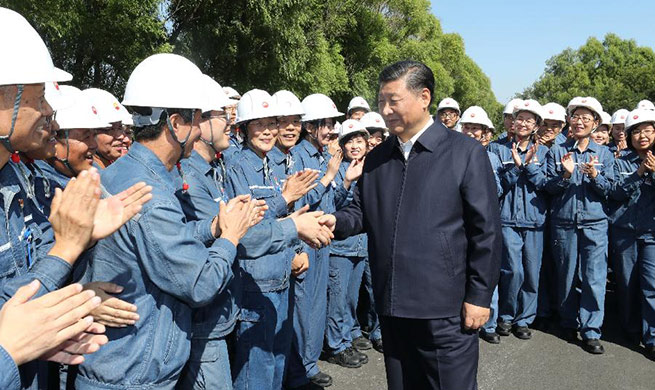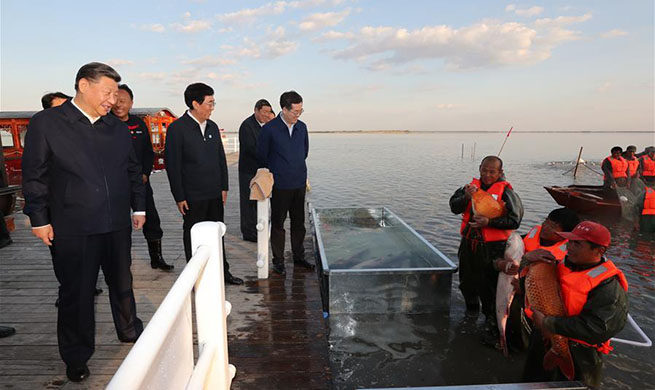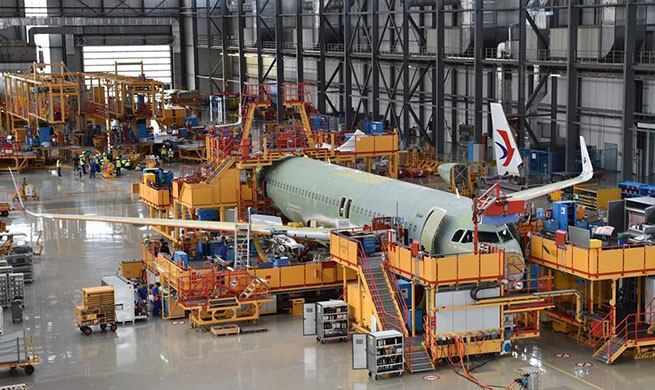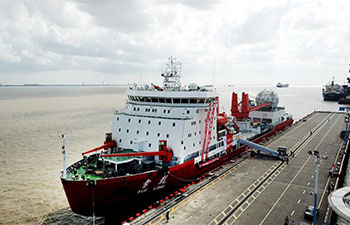by Xinhua writers Su Liang, Chen Yao
BEIJING, Sept. 27 (Xinhua) -- Like many farmers in Maringa, a municipality in southern Brazil, Manoel Marques has decided to expand his soybean planting from 6,800 to 7,100 hectares for the 2018-2019 season, as China is increasing its soybean imports from the Southern American country.
About 8,500 km to the north, however, American farmer Don Lutz of Scandinavia, a town in the northern state of Wisconsin, feels uneasy about the coming soybean harvest. He has begun to think about planting other crops for the next season as trade tensions between the United States and China show no sign of abating.
The protectionist measures by the United States have caused chaos in the international market, with soybeans now posing a burden for U.S. growers but an opportunity for Brazilian ones.
U.S. LOSSES
China began importing soybeans in 1996. In recent years, it has become the main destination for U.S. soybeans.
Lutz, aged 65, still remembers the rapid increase in Chinese demand for U.S. soybeans over the past decade.
"Ten years ago, out of every four rows of soybeans that grew up, one was exported to China," said Lutz in his farmyard, looking at the mature beans. "Nowadays exports to China have increased to one in three."
The U.S. Department of Agriculture (USDA) estimated in August that local production of soybeans for the 2018-2019 season will break its record and reach 4,586 million bushels.
However, Lutz is worried about a possible loss in the Chinese market after Beijing imposed some retaliatory additional tariffs.
As a result, the price of soybeans on the Chicago Mercantile Exchange (CME), the world's largest derivatives market, fell 20 percent, reaching the lowest level in the past decade.
The Port of Long Beach also felt the shock. Located in California, the port has China as its main trading partner and is one of the major soybean export hubs to China.
Although the full impact of the trade tensions is too early to be seen, 7 percent of the port's total revenue will be affected by the first round of tariffs, said Noel Hacegaba, deputy executive director of Administration and Operations for the Port of Long Beach.
BRAZIL TO FILL THE GAP
In contrast to the gloomy U.S. farmers, Brazilian soybean growers are glimpsing an opportunity.
The price of Brazilian soybeans has risen by more than 15 percent year-on-year, thanks to increased demands from the Chinese market.
The export of Brazilian oilseed to China in the first seven months reached 43.9 million tons, which accounts for 80.6 percent of the total, according to the Brazilian Ministry of Agriculture.
Seeing the opportunity, Marques has decided to expand his oilseed planting.
"In the past season 2017-2018, we extended the sowing for 4 percent more and we had a good income," the 65-year-old farmer told Xinhua. "For the new cycle, we tried to expand more, up to 7,100 hectares and getting an increase of 4.4 percent."
In the next ten years, soybean production in Brazil will reach 156 million tons, which means an overall increase of 30 percent, according to research conducted by the Ministry of Agriculture and the Brazilian Agricultural Research Corporation.
The report projects that Brazilian soybean exports will reach 96.5 million tons, of which 70 percent will go to China.
Silceu Dalberto, president of Cotrimaio, an agricultural cooperative in the southern state of Rio Grande do Sul, also wants to increase his planting by 3.5 percent.
Cotrimaio plans to focus more on the Chinese market. Wang Guoliang, Cotrimaio's partner in China, said Chinese buyers and Brazilian farmers can establish a cooperation scheme in which the Chinese side offers fertilizers and the Brazilian side exports soy.
"These days Brazilian soybean exports are controlled by the major international distributors, but this scenario will change with the fast increase of soybean trade between China and Brazil," Wang predicted.
NOT ALL ROSY
For CME agricultural market analyst Virginia McGathey, U.S. soybean farmers have become victims of trade frictions between China and the United States, while Brazil and its farmers stand to benefit.
"This is perfect for Brazil and I know that they are going to use the money they receive from the purchases from China to improve their infrastructure and improve their competitive edge," said McGathey.
Bernardino Braz, president of the Association of Soybean Producers of Brazil (Aprosoja), believes that U.S. protectionism can be an opportunity for Brazil to expand its soybean exports to China.
"What we do need is to have greater credibility for the future, more alliances to maintain growth, and stronger relationships," said Braz. "We can do it in the medium and long term, (and) we have to have confidence to achieve that goal."
Not all sectors in Brazil, however, can benefit from U.S. protectionism, said Marcos Jank, CEO of Asia-Brazil Agro Alliance.
"It seems that the oilseed sector will benefit, but the price increase will increase the cost of livestock and reduce the competitiveness of Brazilian meat products in the international market," Jank said.
The trade frictions caused by U.S. protectionism will distort the global supply chain and increase uncertainty in the international market, the specialist in agribusiness said.
(Xinhua correspondents Chen Weihua and Zhao Yan from Rio de Janeiro, Peng Hua from Sao Paulo, Gao Shan from Los Angeles, Wang Ping from Chicago and Gao Pan and Sun Ding from Washington D.C. also contributed to the report.)

















